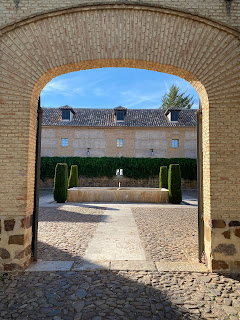La Mancha; Almegro; Ubeda
La Mancha is an area of Spain that many have heard of but perhaps few have visited. It is of course famous for being the home territory of Don Quixote. The local authorities have concocted, for the gullible tourist, somewhat implausible Quixote itineraries.
But the real interest, even on a two-day visit, lies elsewhere.
If, like me, you have spent a lot of time in Andalucía, you get firmly implanted with an idea of Spain that combines Coast (often overdeveloped tourist resorts), Mountains and romantic Towns and Cities. These last bear witness to successive civilisations and successive conquests – Ronda, Sevilla, Malaga, Cordoba, and Granada, to name some of the first among equals.
Heading north to what is more or less the centre of Spain, I was struck by absences. Absence of frequent human settlements; absence of frequent hills and valleys (although nowhere in Spain is without some distant craggy ridge). Roads run straight and pretty flat. Clearly a place where the wind could get up, a place for tilting and windmills.
Our destination was Almagro and its Parador hotel. This is emblematic of the town’s history. It was once a vast monastery, built in Renaissance times, when Almagro was wealthy and flourishing, of which more later.
In the earlier Middle Ages Almagro had a more austere role. It was the headquarters of one of those strange oxymoronic products of militant Catholicism – the armed monastic orders, basically fanatic Christian knights, who prayed and lived like monks and battled like elite soldiers.
These Orders evolved to provide a standing military force for the church’s crusades (the Knights Templar being the most famous, or notorious). In Spain, Christianity was busy with the long (800 years) Reconquista of the peninsular from the Moors. Again, the lack in those times of a secular standing army was a problem, both to lead assaults and to watch the contested frontiers.
The Calatrava Order was the foremost Spanish military order. They garrisoned Almagro when it was on the border of Moorish territories. Later, when the frontier moved further south for the last 200 years before the fall of Granada in 1492, the Order’s headquarters moved to an extraordinary crag-top fortified monastery a few kilometres from Almagro, guarding a key pass.
By Renaissance times, Monks Militant were becoming redundant and, in Almagro, were replaced by Bankers Resplendent. The Fugger family from Germany, and their acolytes, were bankers (ie massive lenders) to the Spanish Emperor. He, to ameliorate the burdens of repayments, granted valuable mining concessions to the Fuggers.
The Fuggers and colleagues used their wealth to build town houses and churches. Most idiosyncratically, they created the Plaza Mayor, an unique product of Hispanic-Germanic style. The Plaza features extensively glazed wooden apartments above a stone colonnade stretching for 100 metres or so on either side of a great open space.
We were told the town burghers, once upon a time, watched bull fights in the Plaza from these high vantage points – then they were unglazed and open, basically posh bull-side boxes. The bulls moved to a bespoke ring on the edge of town, and the windows arrived.
Secluded off one side of the Plaza is an old open roofed theatre – a Spanish equivalent of London’s Globe (though the latter is a replica). The structure is very famous among connoisseurs of theatrical architecture. For many years it was hidden in the interior depths of a tavern. Interesting, but not as intriguing as the Calatravan soldier monks.
There are some particularly beautiful cloisters, once part of a convent (Convento de la Asuncion).
The convent fell victim to one the expropriations of Church property in the C19, and for a while was used as cavalry barracks. The damage that occupation caused has been restored.
That there were such expropriations at all in deeply Catholic Spain is somewhat astonishing. But the motivation was economic rather disputes about religion. The State was always teetering on the edge of bankruptcy. The Church’s vast lands were underworked – and untaxed. Expropriation therefore aimed at two goals: raising money for the State by the sale of lands, and boosting low productivity and miserable living standards by better agricultural exploitation.
The achievement of the latter goal was not wholly successful. In the South, especially Andalucía, the lands were bought up by existing landowners, who in most cases did little or nothing to improve the lot of the peasants. This situation, and its associated grievances, have persisted into modern times.
On the way to Almagro we spent a night in Ubeda, visited five years before. This is another city with a Renaissance core, but very different to Amalgro. Ubeda and its near neighbour Baeza were fortresses dominating a high ridge on the final Granada frontier. When the Moors lost the area in the C13, Ubeda was turned over, not to monks militant, but to warrior barons. They feuded bloodily among themselves for control of the city, but they did leave another Plaza, surrounded by gracious and grand buildings, including the palace that now houses the Parador.
Ubeda has another hidden historical structure, discovered in the basements of a modest terrace of houses. This is the Sinagoga de Agua, a small medieval synagogue, its stone and wooden structures well preserved. It is truly old, for historical synagogues in Spain must pre-date 1492, when practising Jews were expelled from the kingdom, ending any eras of toleration, if such ever were, except intermittently and locally under both Christian and Moorish rule (Toledo and Cordoba being respective examples).
November 2021









No comments:
Post a Comment